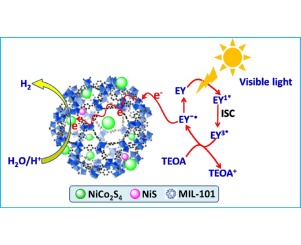Abstract: Low overpotential co-catalyst is a key component for a photocatalyst in photocatalytic hydrogen generation. Dual transition metal sulfide is known as a candidate in replacing noble metal. Its property is highly dependent on its surface structure and chemical state. In this paper, we found that the hydrogen adsorption energy (AGH) on various dual metal sulfide CoxNi(4-x)S(4) co-catalysts could be adjusted by variation of Co and Ni ratio. The hydrogen adsorption energies over Co and Ni sites in Co2Ni2S4 catalyst were 548.7 and 506 kJ mol(-1) respectively, while the corresponding energies over CoNi3S4 and Co3NiS4 catalysts were much higher than the data over Co2Ni2S4 catalyst. It was found that the XRD peaks of (220) facet of CoxNi(4-x)S(4) shifted from 26.27 to 26.53 when Co/Ni ration varied from 3 to 1, while other facet XRD peak location did not changed, indicating surface structure of (220) facet was adjusted and could be artificially controlled. In optimized Co2Ni2S4 co-catalyst surface, the intermediate during hydrogen formation is much more stable than over other CoxNi(4-x)S(4) co-catalyst. The surface chemical state were also controlled by Co and Ni ratio, the corresponding Co 2p(3/2) of CoxNi(4-x)S(4)@MIL-101 samples shifted to higher energy side when the Co/Ni ratio changed from 3:1 to 1:3, while Ni 2p(3/2) shifted to low energy side, which implied the composition and surface structure change leading to subtle Variation of surface chemical state, as a result, it affected the properties of co-catalyst. The electrochemical and fluorescence measurement results indicated that the Co2Ni2S4@MIL-101 exhibited the highest transient photocurrent, the lowest overpotential (-0.33 V) and the longer fluorescence lifetime (1.49 ns). The obtained Co2Ni2S4@MIL-101 catalyst exhibited excellent activity for hydrogen generation (882.7 mu mol H-2 in 2 h), better stability and higher apparent quantum efficiency (AQE) of 48.9% under visible light irradiation (>430 rim). The high photocatalytic efficiency of Co2Ni2S4@MIL-101 catalyst can be attributed to the low AGH over Co2Ni2S4 co-catalyst, stable reaction intermediate during hydrogen formation and better photoelectrochemical properties. KeyWords Plus: METAL-ORGANIC FRAMEWORKS; HIGH-PERFORMANCE SUPERCAPACITORS; DENSITY-FUNCTIONAL THEORY; EVOLUTION REACTION; NANOTUBE ARRAYS; GRAPHENE; WATER; NANOPARTICLES; CATALYST; LIGHT Published in APPLIED CATALYSIS B-ENVIRONMENTAL, 206 353-363; 10.1016/j.apcatb.2017.01.048 JUN 5 2017 
|

